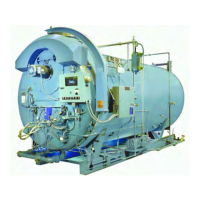Chapter 4 — Sequence of Operation
Part No. 750-184 4-7
caused by failure to ignite the pilot, or the main flame, or by loss of flame.
Lockout will also occur if flame or flame simulating condition occurs during
the prepurge period.
The control will prevent start-up or ignition if limit circuit controls or fuel
valve interlocks are open. The control will lock out upon any abnormal
condition affecting air supervisory controls wired in the running interlock
circuit.
The lockout switch must be manually reset following a safety
shutdown. The cause for loss of flame or any unusual condition
should be investigated and corrected before attempting to restart.
Failure to follow these instructions could result in serious personal
injury or death.
1. No pilot flame
The pilot flame must be ignited and proven within a 10-second period after
the ignition cycle begins. If not proven within this period, the main fuel valve
circuit will not be powered and the fuel valve(s) will not be energized. The
ignition circuit is immediately deenergized and the pilot valve closes, the
reset switch lights and lockout occurs immediately.
The blower motor will continue to operate. The flame failure light and the
alarm bell (optional) are energized 10 seconds later.
The blower motor will be deenergized. The lockout switch must be manually
reset before operation can be resumed (refer to the previous caution).
2. Pilot but no main flame
When the pilot flame is proven, the main fuel valve circuit is energized.
Depending upon the length of the trial-for-ignition period, the pilot flame will
be extinguished 10 or 15 seconds later. The flame detecting circuit will
respond to deenergize the main fuel valve circuit within 2 to 4 seconds to
stop the flow of fuel. The reset switch lights and lockout occurs immediately.
The blower motor will continue to operate.
The flame failure light and alarm bell (optional) are energized 10 seconds
later.
The blower motor will be deenergized. The lockout switch must be manually
reset before operation can be resumed (refer to the previous caution).
3. Loss of flame
If a flame outage occurs during normal operation and/or the flame is no
longer sensed by the detector, the flame relay will trip within 2 to 4 seconds
to deenergize the fuel valve circuit and shut off the fuel flow. The reset switch
lights and lockout occurs immediately. The blower motor continues
operation. The flame failure light and alarm bell (optional) are energized 10
seconds later.
The blower motor will be deenergized. The lockout switch must be manually
reset before operation can be resumed. (Refer to the previous caution.)
If the burner will not start, or upon a safety lockout, the trouble shooting
section in the operating manual and the technical bulletin should be referred
to for assistance in pinpointing problems that may not be readily apparent.

